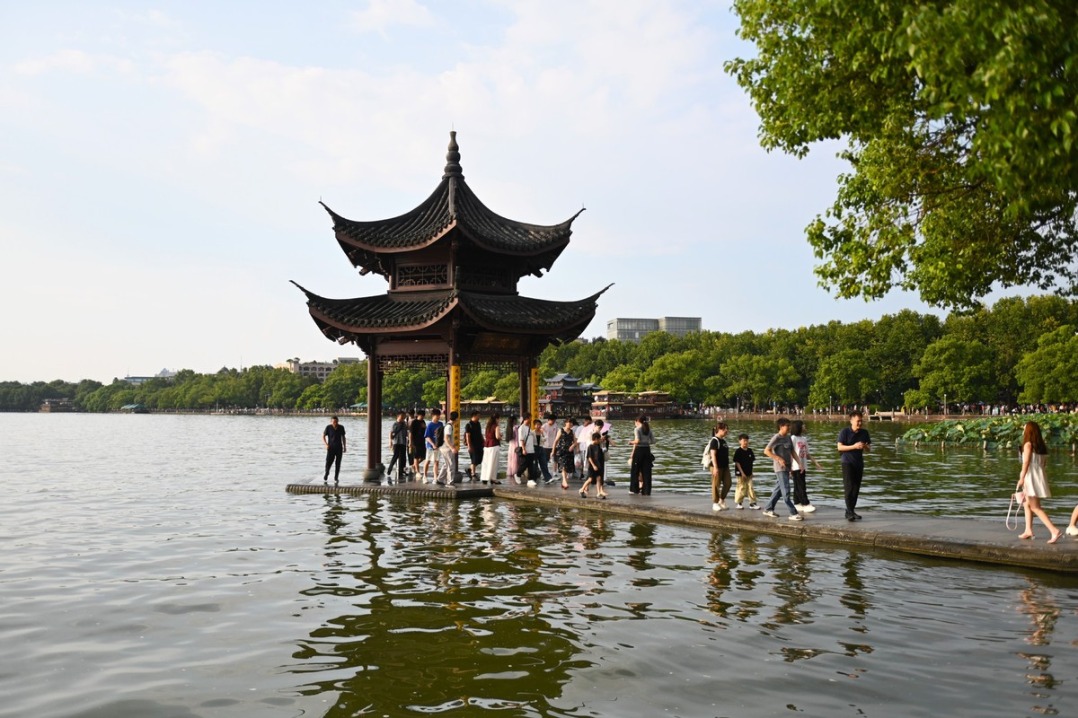Elephantine zeal

Natarajan Ishwaran, a wildlife conservationist, aims to use technology to promote better management of natural habitats
Natarajan Ishwaran has a special affinity for the Asian elephant. It roams wild in his country, Sri Lanka, where domesticated ones are used to ferry tourists around. He studied the animal through his doctoral program. Now he uses state-of-the-art technology to promote the conservation of natural habitats for them and other creatures.
All this from his Beijing office at International Centre on Space Technologies for Natural and Cultural Heritage, a United Nations agency, where he is a visiting professor.
| Wild elephants enjoy fun in the water in the forests of Yunnan province, one of the few habitats remaining for the large endangered species in China. Provided to China Daily |
| Natarajan Ishwaran, a wildlife expert of Sri Lankan origin. Kuang Linhua / China Daily |
Ishwaran served in UNESCO from 1986 to 2012. He is an expert on wildlife that also includes "small and less-known animals and plants", he says.
But he does not hide his preference for "the big ones" because they "give the inspiration for a much broader range of life to be conserved".
The Asian elephant is "a symbolic animal" and "an iconic species" just like the giant panda in China, Ishwaran says, adding that big animals are more difficult to keep than smaller ones whose spatial requirements are more modest.
Although China has many nature reserves, some aren't well protected while others have "intervening areas" that are used for farming and forestry and even include small towns. The requirements of people often become major challenges to biodiversity and the protection of big animals in particular.
"Wolong (in Sichuan province) alone is not enough to protect the giant panda", an animal that has been the symbol of World Wide Fund for Nature since its founding in 1961, he says.
Big animals also feature more prominently in local culture and economy. The Asian elephant has been used in wars, temples and the timber industry, he says, and in India, the elephant-faced deity Ganesha is worshipped. The challenge is especially acute in Asia, where the growth of the human population has put much pressure on open spaces.
Ishwaran, 63, however, isn't an activist who goes around carrying a plaque that reads, "no humans allowed".
Balancing development and conservation is case by case, he emphasizes. You cannot adopt the same protective measures in elephant country as in tiger territory. For one thing, elephants may come and raid your crops whereas tigers come to eat your chickens and goats!
Things like elephant raids are not a daily occurrence and there should be insurance and compensation schemes to offset financial losses suffered by local farmers, he suggests. But since China's elephant population is so low, there is no doubt in his mind that incidents like the occasional crop raid have little danger of upsetting the larger picture.
The big picture, of course, is that human activities are intruding into wildlife. The conflict has forced Ishwaran to think about the way agriculture is conducted, especially in Asian countries like China.
"Perhaps there are opportunities to reform the ways (in which) rural land is used," he says. "Perhaps you don't need to focus on the old way, small-scale agriculture, but shift to the model of less land and higher productivity."
Witness to the changes
He first visited China in 1989 as a program officer for UNESCO's World Heritage Convention. China was "less constructed" then, but not necessarily "more natural", Ishwaran says. Since then, he has made many visits to the country and has not only witnessed changes in urbanization, but also improvements in "skills and the capacity to manage natural and cultural heritage".
China has had its share of "comments and criticisms" from the international community, but they are taken very seriously. "In general, China has been a great supporter of international programs," he says.
Among which, the most famous focuses on UNESCO's World Heritage sites, of which China currently has 47. There are also the Global Geoparks Network, and very much close to his heart, the Man and Biosphere program, which manages the World Network of Biosphere Reserves.
As the former secretary of MAB, he feels it is underrated in China and many other countries, especially compared with the popular World Heritage program. But a biosphere reserve not only covers a protected zone, but a much larger area that is intended for balancing development and conservation, he says.
Changbai Mountain, which he visited on his first trip to China, is a biosphere reserve, and China had 32 such reserves by the end of 2014.
In his mind, the MAB program is ideal for testing new ideas. These zones can be "interesting experimental areas to see what could change and what could not" and how sectors like energy, agriculture and forestry could evolve in a manner so as to make more "space for biodiversity".
He recalls the warning of a UN official on the management of Mount Huangshan, which got its World Heritage status in 1990, and immediately saw a profusion of tourism facilities.
"Tourism is an industry that consumes capital and requires infrastructure," he says. "With a whole hospitality sector, it can end up being unsustainable in the way it expands and proliferates." Following the warning, Ishwaran went to Huangshan along with other experts to help.
"Huangshan today is a very well managed site," he adds.
"Maintaining balance does not mean a rigid plan," he says. "There will be times when you go up and down and make necessary corrections."
New technology
With the biosphere program, more high-end technologies can be applied to streamline an approach that seeks to make people's economic progress move alongside the proper management of wildlife habitats.
Satellite and terrestrial technologies could be deployed to scan large areas for changes, and used to work out specific requirements of programs that wish to balance development and conservation in specific places.
"Success is not guaranteed, but you'll have to keep trying," Ishwaran says.
When compared with other countries, China's development is perceived to have been "hardware" driven, such as building of roads and bridges. But Ishwaran says, China's expertise in space and other sciences also is an important part of its soft power in international relations.
As he points to a screen in the lobby of the Institute of Remote Sensing and Digital Earth, a China Academy of Sciences affiliate, a live satellite image moves slowly.
"This is relayed to Angkor Wat in Cambodia," he says. "So people there can use it for detecting problems and managing their area."
Ishwaran isn't ready to retire yet. But even when he does and settles down in Paris, where his wife works, he says he may "go in and out and do a few things here".
China is a place that "impresses you to an extent that you want to keep coming back and spend more time", he says.
raymondzhou@chinadaily.com.cn
(China Daily Africa Weekly 04/17/2015 page29)
































